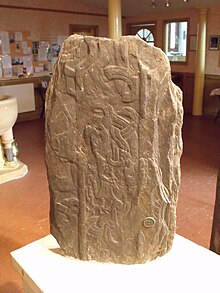Sigurd's Cross
The Sigurds Cross ( English "Siguards Cross; also called Fafnir's Bane (curse) - No. 121") is exhibited with five other cross fragments in the church of Andreas ( English "Kirk Andreas") in the north of the Isle of Man . It is one of four so-called Sigurd plates on the island. The other three are in Maughold Kirk ( Sigurd Slab ), Jurby and Malew.
The Siguard's Cross dates from the late 10th century. The upper part of the cross has broken off. The shaft has a wide flat circle with representations on each side. The entire decoration is free of Celtic influences and the border decoration consists of zoomorphic images and wickerwork.
One side is decorated with the hero Sigurd and the dragon Fafnir . At the bottom is the illustration of Sigurd killing the dragon with his sword. Above, Sigurd is shown above the fire in which Fafnir's heart is roasting, and he cools the burned fingers in his mouth. One of the birds sits on his back while his stallion Grani (the gray one) stands above. The other side shows a mutilated figure with a snake, which is a later part of the legend, when Gunnar, who was obsessed with the treasure, is thrown into the snake pit. The scene in which Sigurd stabs the dragon with his sword in the pit is most clearly depicted on Jurby's Cross and on Siguard's Cross by Kirk Andreas.
In the 10th century, the Isle of Man was part of the “Kingdom of the Isles” of the Vikings for about 90 years before becoming part of the Kingdom of Orkney in 989 .
Web links
Individual evidence
- ↑ Since he also eats the heart roasted especially for Regin, he can understand the language of the birds, learns of Regin's betrayal and kills the dwarf.
Coordinates: 54 ° 21 ′ 50.6 " N , 4 ° 26 ′ 27.4" W.
